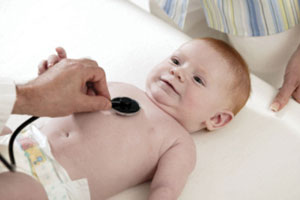ENDOCRINOLOGISTS and screening experts warn that babies are dying because Australia lacks a screening program for congenital adrenal hyperplasia, which is screened for in many other countries.
This week’s MJA reports a case of a 21-day-old boy with undetected congenital adrenal hyperplasia (CAH) who went into cardiac arrest while being taken to hospital, and required resuscitation and defibrillation to survive. (1)
Commenting on the report, Professor Garry Warne, a senior endocrinologist at the Royal Children’s Hospital in Melbourne, told MJA InSight this was a fairly typical story for a boy with CAH, because boys with the condition appear normal at birth.
“They all have to go through a near-death experience that could be prevented by screening”, Professor Warne said.
CAH is most commonly caused by 21-hydroxylase deficiency (21-OHD). The classic phenotypes are salt wasting and simple virilising varieties.
Infant girls with CAH have ambiguous genitalia which usually enables detection of the condition that has an incidence of about 1 in 14 000 live births. Although CAH should occur equally in boys and girls, Professor Warne said unpublished data from WA showed that the incidence was twice as high among girls, suggesting that many baby boys died before the condition was diagnosed.
Newborn screening for 21-OHD has been conducted in New Zealand for 28 years, and is also carried out in the US, Canada, Japan and much of Europe. Recently Vietnam decided to include 21-OHD screening in its newborn screening program, Professor Warne said.
“Australia is way behind. We think it’s a scandal”, said Professor Warne, who is also chairman of the disordered sex development working group of the Australian Paediatric Endocrine Group.
Coauthor of the MJA paper, Dr Andrew Cotterill, director of paediatric endocrinology at the Mater Children’s Hospital in Brisbane, told MJA InSight that all paediatric endocrinologists and most screening groups supported introduction of screening for CAH.
The MJA paper said that screening for CAH appeared to meet all the population screening criteria.
“CAH results in high morbidity and mortality if undetected; the 21-OHD NBS test is reliable and efficient; there is effective cheap treatment for CAH; and the incidence of CAH is relatively high (similar to phenylketonuria)”, the authors wrote.
Professor Bridget Wilcken, clinical director of the NSW Newborn Screening Program, was involved in a 2-year pilot study, published in 2008, which screened 185 854 newborns for CAH in NSW and the ACT and detected 12 infants with the condition, including six boys. (2)
Professor Wilcken advised that the public health benefit of screening was relatively small, but she said she still thought screening should be introduced. “Screening is life saving, but only very occasionally”, she said.
All the experts MJA InSight spoke to said that Australia needed a better process for introducing new screening tests, rather than the current state-by-state process.
Professor Warne said his working group had been bounced between state and federal bodies trying to get the screening test introduced.
A spokeswoman for the federal Health Department said there had not been an application to the Medical Services Advisory Committee to introduce screening for 21-OHD, as was required before the listing of any service on the Medicare Benefits Schedule could be considered. The committee would consider public funding of this test if it received an eligible application, she said.
– Sophie McNamara
1. MJA 2011; 195: 260-262
2. Journal of Paediatrics and Child Health 2008; 44: 554-559
Posted 5 September 2011

 more_vert
more_vert